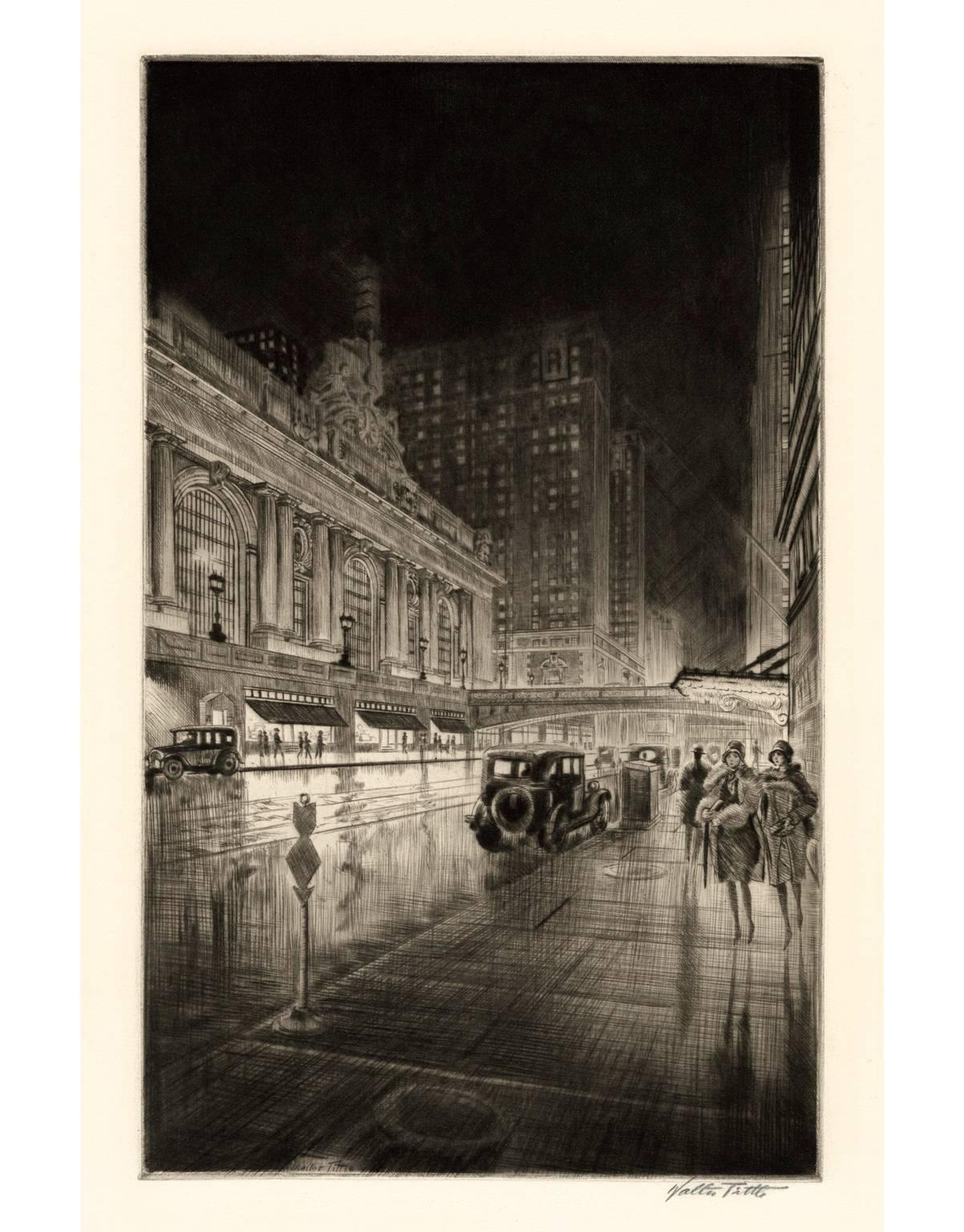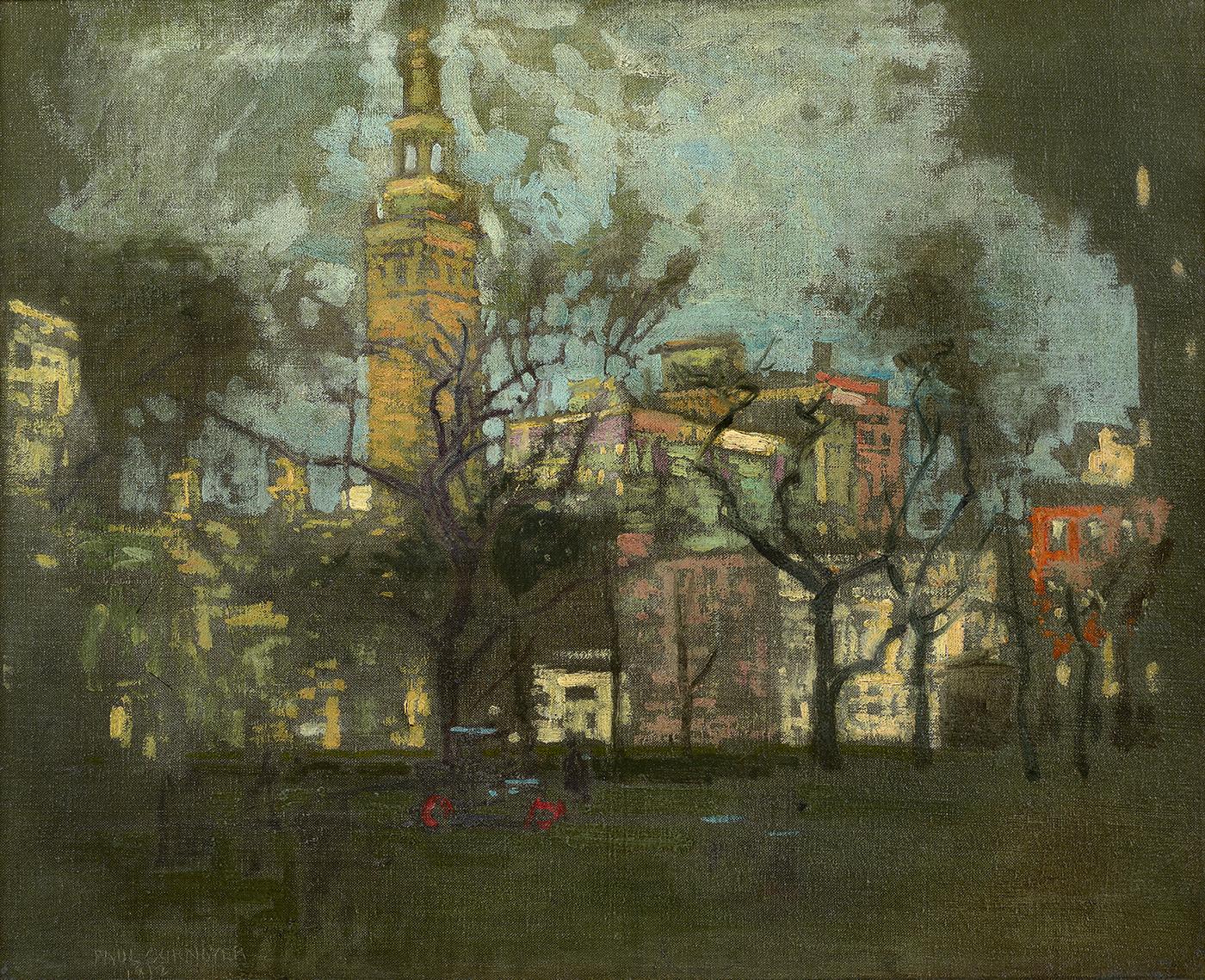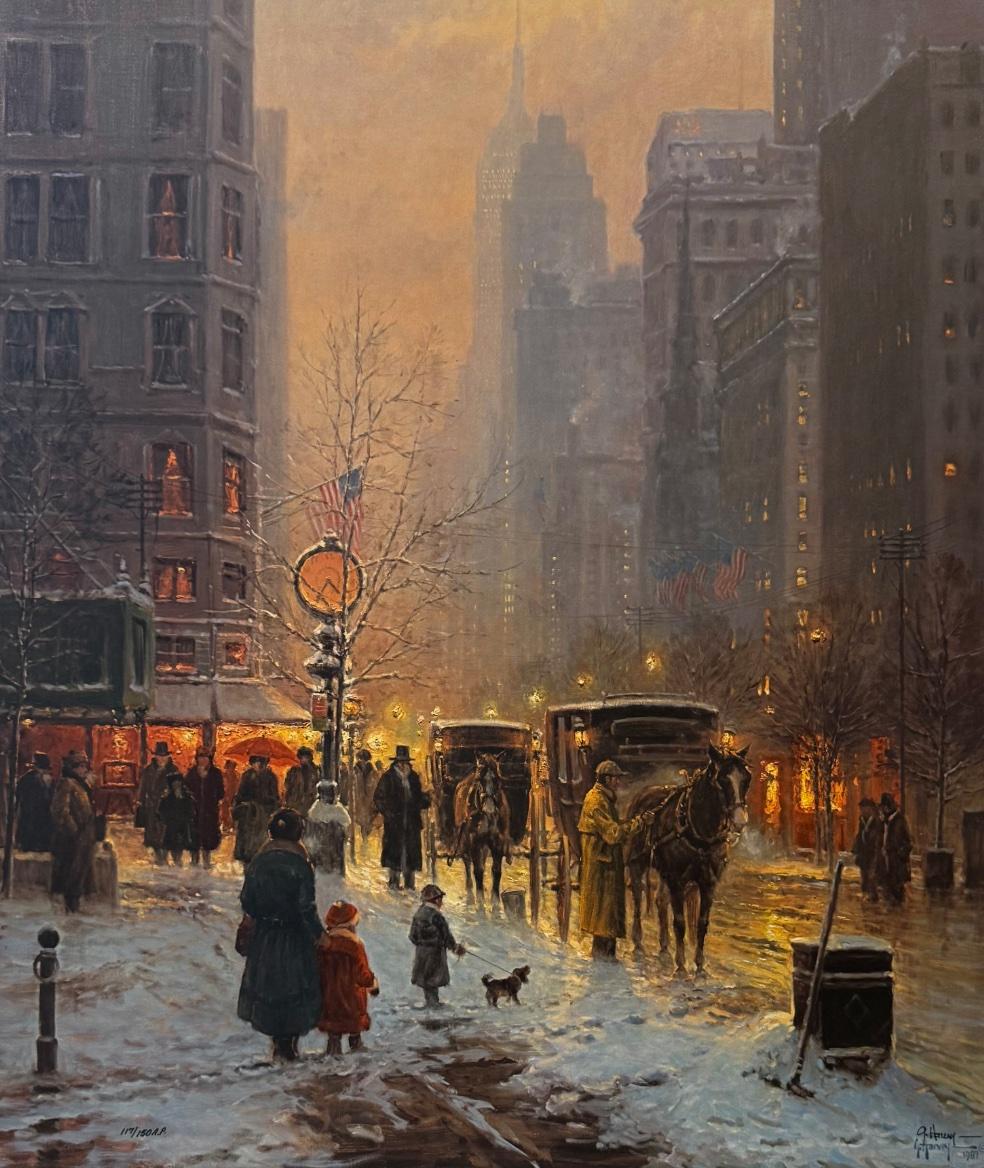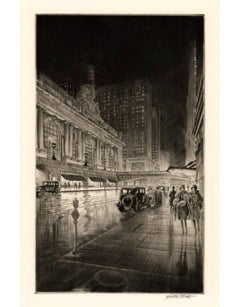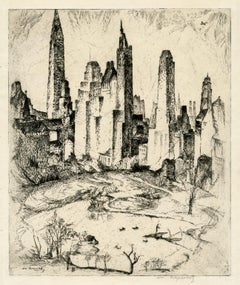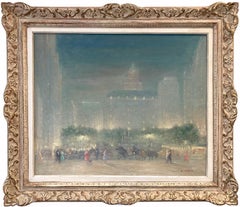Items Similar to The Plaza, Sunset Glow
Want more images or videos?
Request additional images or videos from the seller
1 of 3
Walter TittleThe Plaza, Sunset Glowc. 1920s
c. 1920s
$1,400
£1,041.36
€1,219.23
CA$1,953.48
A$2,185.99
CHF 1,141.42
MX$26,874.52
NOK 14,400.37
SEK 13,550.68
DKK 9,096.40
Shipping
Retrieving quote...The 1stDibs Promise:
Authenticity Guarantee,
Money-Back Guarantee,
24-Hour Cancellation
About the Item
'The Plaza, Sunset Glow', drypoint, c. 1920s, edition not stated. Signed in pencil and initialed in the plate, lower right. Titled 'The Plaza, Sunset' and annotated 'no. 165' in ink, in the bottom left sheet corner. A superb, luminous impression in dark brown ink, with selectively wiped plate tone; on cream wove paper; the full sheet with margins (1 to 2 1/4 inches). Pale tape stains on the top sheet edge, recto, well away from the image, otherwise in excellent condition. Matted to museum standards, unframed.
A view across 'The Pond' in New York City's Central Park, toward Grand Army Plaza, with the Plaza Hotel on the right.
Impressions of this print are in the permanent collections of the British Museum; Victoria and Albert Museum, London.
- Creator:Walter Tittle (1883 - 1966, American)
- Creation Year:c. 1920s
- Dimensions:Height: 11.75 in (29.85 cm)Width: 6.94 in (17.63 cm)Depth: 0.01 in (0.26 mm)
- Medium:
- Movement & Style:
- Period:
- Condition:
- Gallery Location:Myrtle Beach, SC
- Reference Number:Seller: 1032551stDibs: LU53232636213
About the Seller
5.0
Recognized Seller
These prestigious sellers are industry leaders and represent the highest echelon for item quality and design.
Platinum Seller
Premium sellers with a 4.7+ rating and 24-hour response times
Established in 1995
1stDibs seller since 2016
308 sales on 1stDibs
Typical response time: 1 hour
Associations
International Fine Print Dealers Association
- ShippingRetrieving quote...Shipping from: Myrtle Beach, SC
- Return Policy
Authenticity Guarantee
In the unlikely event there’s an issue with an item’s authenticity, contact us within 1 year for a full refund. DetailsMoney-Back Guarantee
If your item is not as described, is damaged in transit, or does not arrive, contact us within 7 days for a full refund. Details24-Hour Cancellation
You have a 24-hour grace period in which to reconsider your purchase, with no questions asked.Vetted Professional Sellers
Our world-class sellers must adhere to strict standards for service and quality, maintaining the integrity of our listings.Price-Match Guarantee
If you find that a seller listed the same item for a lower price elsewhere, we’ll match it.Trusted Global Delivery
Our best-in-class carrier network provides specialized shipping options worldwide, including custom delivery.More From This Seller
View All'Grand Central, Night' — 1920s New York City Realism
By Walter Tittle
Located in Myrtle Beach, SC
Walter Tittle, 'Grand Central Night', drypoint, edition not stated, c. 1920s. Signed in pencil. Titled, and annotated '36.00' and with the inventory numb...
Category
1920s American Impressionist Landscape Prints
Materials
Drypoint
'Pulitzer Fountain, Evening" — 1940s American Modernism, New York City
By Ellison Hoover
Located in Myrtle Beach, SC
Ellison Hoover, 'Pulitzer Fountain, Evening', lithograph, circa 1940, edition c. 40. Signed in pencil. A fine, atmospheric impression, on cream wove paper; the full sheet with margins (1 1/2 to 4 5/16 inches), in excellent condition. Archivally matted to museum standards, unframed.
Image size 12 1/2 x 9 5/8 inches (318 x 244 mm); sheet size 16 1/4 x 12 1/4 inches (413 x 311 mm).
ABOUT THE SUBJECT
The Pulitzer fountain was commissioned as a bequest by Joseph Pulitzer, newspaper publisher and founder of the Columbia School of Journalism. Designed by Austrian sculptor Karl Bitter...
Category
Mid-20th Century American Modern Landscape Prints
Materials
Lithograph
$1,760 Sale Price
20% Off
Broad Street (Wall Street)
By Bror Julius Olsson Nordfeldt
Located in Myrtle Beach, SC
B.J.O. Nordfeldt, 'Broad Street (Wall Street)', etching, edition not stated, c. 1915. Signed in pencil. A superb impression, with rich burr, selectively wiped plate tone, and inky plate edges, on cream wove paper; the full sheet with margins (3/4 to 1 1/4 inches), in excellent condition. Printed by the artist. Matted to museum standards, unframed.
Impressions of this work are in the permanent collections of the Fine Arts Museums of San Francisco, Princeton University, Smithsonian American Art Museum.
A view looking down Broad Street past the New York Stock Exchange Building on the right with the columned Federal Hall...
Category
1910s American Impressionist Landscape Prints
Materials
Etching
'New York, Central Park' — 1930s American Modernism
By William Meyerowitz
Located in Myrtle Beach, SC
'New York, Central Park', etching, edition 40, c. 1930. Signed in pencil. Titled and numbered '14/40' on the bottom sheet edge, in pencil. Signed in the plate, lower left. A superb, ...
Category
1930s American Modern Landscape Prints
Materials
Etching
'Downtown, New York' — 1920s Modernism
By John Taylor Arms
Located in Myrtle Beach, SC
John Taylor Arms, 'Downtown, New York', etching with aquatint, 1921, edition 75, Fletcher 108. Signed, dated, and numbered 14/75 in pencil.
A superb, finely nuanced impression, in d...
Category
Early 20th Century American Modern Landscape Prints
Materials
Etching
'Grand Central Station' — New York City Landmark
By Otto Kuhler
Located in Myrtle Beach, SC
Otto Kuhler, 'Grand Central Station', etching and drypoint, 1927, edition c. 50, Kennedy 27. Signed and titled in pencil. A superb, richly-inked impression, in brown/black ink, with ...
Category
1920s American Impressionist Figurative Prints
Materials
Drypoint, Etching
$2,080 Sale Price
20% Off
You May Also Like
"Evening at the Grand Army Plaza" Impressionist 5th Ave NYC Oil Painting Canvas
By Johann Berthelsen, 1883-1972
Located in New York, NY
A stunning jewel and pertinent example of Berthelsen's charming New York City scenes. Here we find a nocturne scene with The Pulitzer Fountain at Grand Army Plaza on Fifth Avenue loo...
Category
Mid-20th Century American Impressionist Landscape Paintings
Materials
Oil, Canvas
Madison Square Garden at Night
By Paul Cornoyer
Located in New York, NY
Signed and dated lower left: PAUL CORNOYER / 1912
Category
20th Century American Impressionist Landscape Paintings
Materials
Oil
Cafe Martin At Night, Madison Square Park, New York, dated 1902 Rodighiero
Located in Blackwater, GB
Cafe Martin At Night, Madison Square Park, New York, dated 1902
signed "Rodighiero"
1902 American School nocturnal street scene of Cafe Martin, Madison S...
Category
Early 20th Century Landscape Paintings
Materials
Canvas, Oil
Evening Along the Avenue
By G. Harvey
Located in Wimberley, TX
G. Harvey’s "Evening Along the Avenue" is a quintessential example of the artist’s gift for capturing the golden elegance of a bygone era. With his hallmark touch of romantic realism...
Category
1980s American Impressionist Figurative Prints
Materials
Color, Lithograph
Evening - New York - Impressionist Landscape Oil Painting by Johann Berthelsen
By Johann Berthelsen, 1883-1972
Located in Marlow, Buckinghamshire
Stunning oil on canvas circa 1955 by American impressionist painter Johann Henrik Carl Berthelsen. The piece depicts a view of the illuminated waterfront buildings from the East Rive...
Category
1950s American Impressionist Landscape Paintings
Materials
Canvas, Oil
"Walking By The Plaza at Twilight -NYC-" Impressionist Street Scene Oil Painting
By Cindy Shaoul
Located in New York, NY
A charming depiction of The Plaza Hotel in New York City with figures walking down the street, with a horse and carriage scene in the distance. A cozy impressionistic street scene wi...
Category
2010s American Impressionist Landscape Paintings
Materials
Oil, Board

